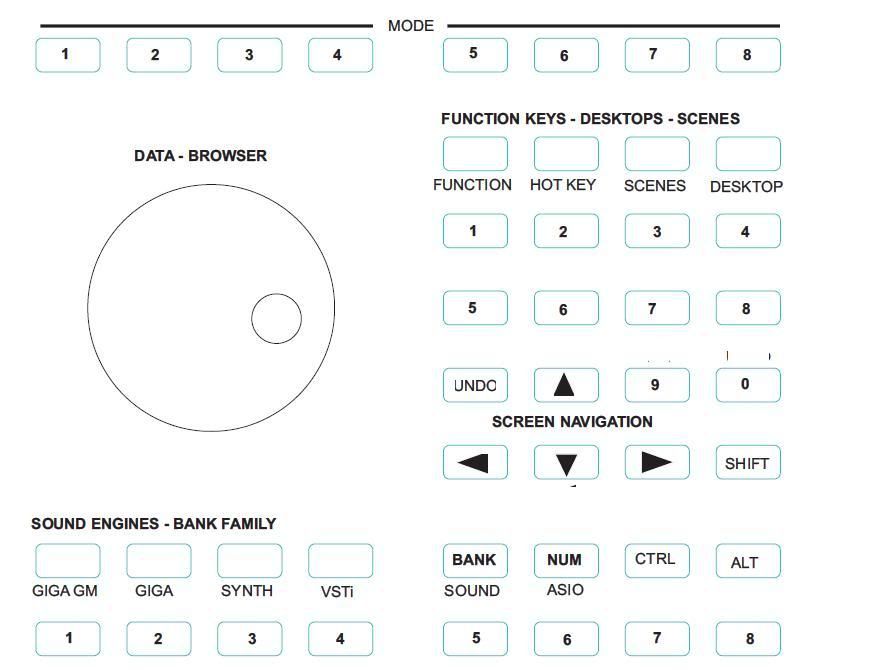Ok, here a small knobs idea specification that I have…
Based from the whole front panel:
http://www.lionstracs.com/demo/GrooveW-X7panel.pdf
LEFT side controls specifications:
MAIN Volumes and ON/OFF system:

POWER= press to power up the PC system and also used for log out/power off
RESET: by fast pressing, will send the midi CC reset, All note off and when you press+HOLD for 4 second will restart the whole Lionstracs OS on default.
4 digital Volumes encooders with Push switch: Each encoder will control the 4 Stereo outputs and when Push the enconder will make the Mute/Unmute. when rotate will also displayed one small GUI on display with the all volumes value status.

Here we have 8 rotary potentiometers with in top the 10 led segment BAR METER as visual value status of each potentiometers.
Bottom the potentiometer we have the 8 relative keys double LED color C1>C8 ( RED/GREEN) that can be used as Mute/Solo mode.
On master mode are used as Mute tracks.
8-16 key= will switch to tracks 1-8 to 9-16 mode
24-32 key= will switch to tracks 17-24 to 25-32 mode.
SOLO/MUTE key= switch the status of the 8 C1>C8 keys from SOLO mode to MUTE mode tracks.
C-C key= will open a new GUI that display another 16 programmable sliders midi CC controller.
INPUTS key= wil open the GUI with the INPUTS I/O connection
MIXER key= will open the GUI with the MIXER I/O connection
MIC key= will open the GUI for manage the 2 Microphones, with effects and plugins.
JACK I/O key= will change desktop and shown the Jack connection Kit GUI.

Here we have the full realtime pattern system control for live stage.
32-64 key= here we can switch Bank pattern from 32 to 64 mode, is like we will have a full 64 PADS remote control.
PAD PLAY key= this will open our PAD Player GUI, where for each key pad can be assigned one Wav-Mp3 file as shot spot.
KEY START key= this key will be used for play the all melody tracks when one chord is pressed ( arranger feature)
FADE key= when pressed will automatically FADE OUT the master volume of renoise.
HOLD key= will continue play the melody tracks when the chord on keyboard is released( arranger feature)
JUMP key= will Jump from patter to pattern with a different logical navigation ( arranger feature)
BEAT key= will change the BEAT pattern mode on Renoise.
LOOP key= will enalbe/disalbe the LOOP pattern on Renoise.
32 Markers-Patterns PAD keys= here we can recall and Jump in realtime to the desidered pattern.
RIGHT side control specifications:

Realtime mode:
PLAYER key= will recall our Lionstracs GUI with the double Audio-midi players
VIDEO key= will enalbe our double player with the LVC Video engine for play 2 Video on players.
EQ BAND key= will shown our master out 8 Audio EQ GUI with programmable presets.
SYSTEM:
V.KEYB key= will open on the display the Virtual PC qverty keyboard for input text.
COPY key= embedded PC COPY function
PASTE key= embedded PC PASTE function
DELETE key= embedded PC DELETE function
8 MODE keys= another 8 keys for recall programmable functions.

60mm big Data-browser encoder with Push switch= ENTER confirmation
FUNCTION KEYS-DESKTOPS-SCENES
FUNCTION key= when enalbe the 8 bottom keys can recall 8+8 programmable PC functions
HOT KEY = when enalbe can recall 8+8 programmable Renoise Hot keys functions.
SCENES key= when enalbe will change the 8 Renoise scenes GUI
DESKTOP key= when enalbe is possible swicth to the 16 Vistual desktop ( 8+8)

SOUNDS ENGINES ( LIONSTRACS OS)
GIGA GM= enalbe to play the Giga Linuxsampler with the GM Giga soundbank mode
GIGA= enalbe to play the Giga Linuxsampler SINGLE user sound mode.
SYNTH= enalbe to play the zynsub synth
VSTi= enalbe to recall the VSTHost for play up to 1270 scenes with native Windows VST.dll
SOUNDS-BANK= will enalbe to select to the 10 Family sounds groups
ASIO-NUM= will enalbe to load and play up to 8 independent ASIO host.

realtime keyboard mode.
TR.UP = global transpose UP
TR.DWN= global transpose down
WHOLE= enalble the keyboard to play the single sound engine on whole keyboard.
COMBI= enalbe our 8 layers sounds COMBINATION manager

Players and Renoise transport.
CALL key= will recall the player mode from DECK A to DECK B ( IF Lionstracs PLAYERS are ealbe)
CUE key= will forward the audio outs to the monitors/Phones.
PLAY-PAUSE-STOP= standard transport features, for our players or the Renoise seq.
REW+FF key= pressing both the keys wil enalbe the RECORD MODE on Renoise.
VOLUME encooder= master volume for the players or Renoise, push for mute/unmute the master out.
PITCH encooder= global transpose of the players, push for recall the default setting. ( on renoise will be a interesting feature too)
BPM encooder= global BPM players and renoise changes, push for recall the deafault value.
Tha’s it… 
Of course we can still define different features and label on panel.
Let me know what you there think about.








